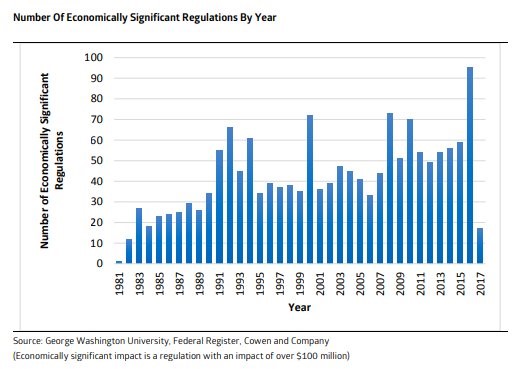The purpose of this article is to objectively examine regulations and the impact on the economy. While there will be discussion of government policy, our review is not negatively nor positively inclined towards any particular administration.
Many in the United States are in favor of increased regulations, however, the unintended consequences of these laws aren’t fully understood – otherwise, we wouldn’t repeat the same mistakes of the past. When a problem is reviewed, the solution is usually a new rule to outlaw the behavior. Unfortunately, you can’t outlaw bad things from happening. Whenever a negative event occurs, it’s easy to get the urge to fix the problem, but it’s rarely considered that the government doing less could help solve the problem. As the popular saying goes, less is more.
Trump Is Working To Cut Regulations
With that being said, new regulation enactments actually slowed in 2017 thanks to the Trump administration. This isn’t an endorsement of President Trump nor of any political faction; it’s an endorsement of lowering regulations. Technically, thus far there hasn’t been deregulation like was promised, but, as you can see from the chart below, the number of significant regulations enacted in 2017 was down about 80% from the number of regulations in 2016.

Trump Lowers Total RegulationsHopefully, this trend continues because one year of results won’t be enough to turn around the economy unless regulations are cut. The fine print shows the regulations included in this chart are ones with an impact of over $100 million. It’s a big task to slow down regulations because the trend has been up for 3 decades. The number of newly enacted regulations in 2017 was the lowest since 1982.
The chart below compares the number of economically significant regulations enacted by month in the first year in office of the past 4 Presidents.

Increasing Regulations Has Been A Bipartisan Effort











Leave A Comment